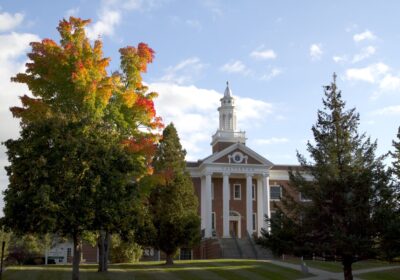Former spartan editor is living with COVID-19 in New York City
Molly DeMellier is a Castleton University alum and former Castleton Spartan editor now working in public relations in New York City, in addition to co-hosting a podcast called “Shooters Gotta Shoot”.
When you first strike a match the serenity of the initial flame makes it almost impossible to imagine that tiny spark can grow to consume homes, office buildings and entire cities. What’s even harder to fathom when looking at the tiny glow at the tip of a matchstick, is how quickly it can all burn down.
That’s how Coronavirus hit New York City.
I first remember hearing about Coronavirus a few months ago from a few friends living in Hong Kong I’d met traveling through Barcelona last summer. They spoke of schools and offices shutting down, bans on public gatherings, a shortage of masks, the government building new hospitals to treat the sick and finally, quarantine.
I felt for them and I feared for them, but I couldn’t really understand what they were going through. As an American, I think in some ways I’m predisposed to believe that extreme measures taken by a foreign government are just that – extreme measures that infringe on civil rights.
For me, this felt like a reminder that Barcelona was the common ground of our friendship and the most evidence I would ever need that we came from different worlds.
A few weeks later, the first case of Coronavirus was reported in the U.S., and soon after in New York City.
The warnings started small, but quickly ignited our city.
Wash your hands for 20 seconds. Carry hand sanitizer everywhere you go. Recommended work from home if you commute on public transit. No gatherings of more than 250 people. Public schools close. Mandatory work from home for all non-essential positions. No gatherings of more than 50 people. Gyms ordered to close. Bars and restaurants close except for take-out orders. No gatherings of more than 10 people. Barber shops, nail salons and tattoo parlors close. Shelter in place order. Our lives in one of the largest, most vibrant cities in the world became confined to our already overcrowded apartments within a matter of days.
Woven into this chaos was also a myriad of misinformation.
Rumors, screenshots of fake text messages from NYPD and NYFD officials and false tweets spread faster than the truth. Perhaps the biggest fallacy of all is that Coronavirus is just another strain of the flu.
This is absolutely not true.

The Coronaviruses are a family of viruses, which include severe acute respiratory syndrome (SARS), Middle East respiratory syndrome (MERS) and now Coronavirus Disease 2019 (COVID-19). Symptoms of COVID-19 do share similarities to flu symptoms including fever, body aches/pains, chills and headache.
However, people suffering from COVID-19 will also experience shortness of breath, cough, respiratory congestion and possibly difficulty breathing.
On Friday, March 20 at around 2 p.m., I tested positive for COVID-19. This was after four days of waiting for test results.
A little before 5 a.m. on March 17, I woke up with a fever, chills, body pains, an excruciating headache, cough and tightness in my chest. I began researching my symptoms and quickly arrived at the notion that I needed to see a doctor.
However, the walk-in center around the block from my apartment didn’t open for another two hours and the closest hospital was an Uber ride away. I sat in the darkness wrestling with what would ultimately cause the least harm. I decided that an Uber ride would probably provide the immediate help for me, but more than likely put countless people at risk of contracting the virus.
So I waited.
When I finally arrived at the walk-in center, I was lucky that the doctor on call was the same doctor who had treated me for the flu in January. He could also tell that my symptoms were slightly different and tested me for COVID-19. Before he administered the test, he apologized for how uncomfortable it was going to be. Then he cradled the back of my head and pushed a swab up my right nostril that I felt stop near the tip of my right eyebrow. With another apology he pulled it out with a drop of blood on the tip.
Before sending me home, the doctor let me know that if the test results were positive, I would receive a call in four to seven days. But, if they were negative, I wouldn’t hear anything at all.
So I went home and I waited.
Before the call came, I already knew the results. I wasn’t getting better. My fever held between a 99 and 103 for a total of five days. My cough has begun to settle in to the point where my laugh has turned to a wheezy bark. And so far, there has been one night that the body pains screamed through my bones keeping me awake.
I consider myself to have a pretty high pain tolerance. I’ve had stitches, staples, wisdom teeth removed without being put under, a knee surgery to put my right knee cap back into place and still run about 35-40 miles a week with no cartilage left in that knee.

This is different.
However, I’m otherwise very strong and healthy, which combined with my age puts me in a very low risk category. This also means that unless I need Emergency Room care I’m to nurse my symptoms at home and wait for the virus to run its course.
Once I’m able to go 72 hours without a fever or respiratory symptoms, I’m allowed to leave my apartment. But there’s no telling when that will be. I’ve been told the second week is the most severe for cough and body pains. As I turn that corner, all I can do is try to remain calm and trust that the body I’ve spent countless hours in the gym to make strong won’t fail me.
What’s more anxiety-invoking than the virus itself, is the cloud of uncertainty it carries. For me, this is not knowing when I can walk out my front door again. For too many of my friends who are now left out of work, it’s not knowing when they will see another paycheck.
I think of this and my cabin fever feels selfish and trite.
I may be sick, but I am one of the most fortunate in all of this madness. I’m young and healthy enough to fight the virus, I have good health insurance and an employer who is supportive of both my physical and mental health, as well as family and countless friends checking in on my well-being.
Too many people don’t have any of these things.
As a society, we are going to be feeling the impacts of Coronavirus for a long time. Unemployment is going to skyrocket and the economy is going to suffer, perhaps in ways not felt since the Great Depression. This is the time to give if you’re able. If your local businesses are temporarily closing their doors, buy gift certificates to help support them during this down time. To support national organizations visit CharityNavigator.org.
As a city and broader society we always bounce back, but not without the help of our neighbors.








